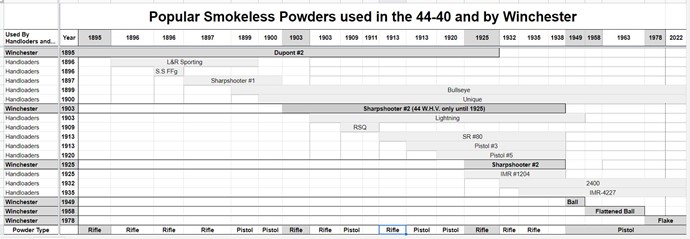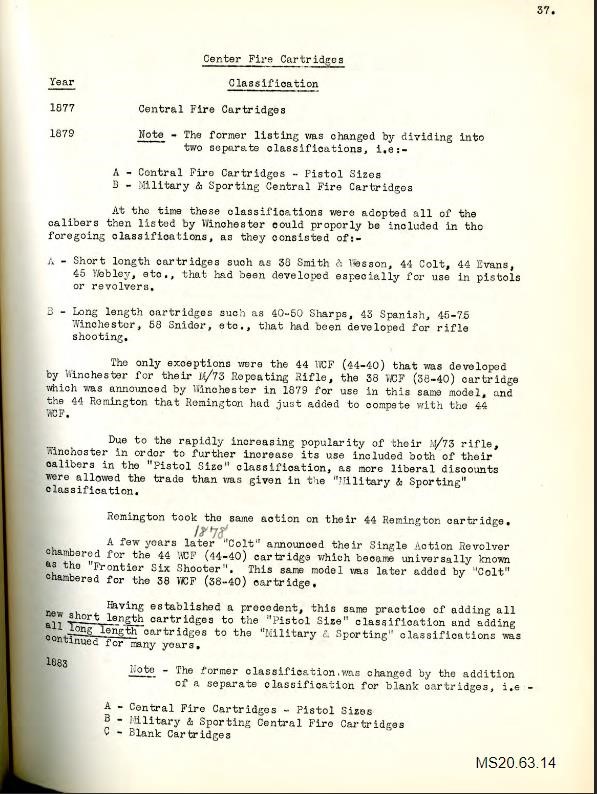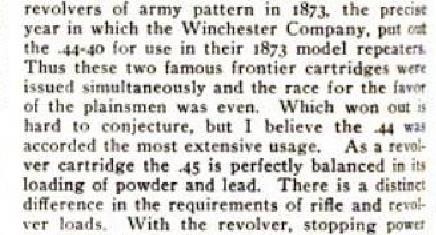More vintage data on the still newer smokeless powders...only 20 old years at the time...and still confusion between fast burning pistol powders vs slower burning rifle powders being used in pistol sized cartridges.
I did not say Pistol Cartridges nor did I say Pistol Caliber, I said PISTOL SIZED CARTRIDGES
I reiterate;
The 44 W.C.F. cartridge came into this would as a black powder pistol sized rifle cartridge used in both revolvers and rifles by the late 1870's. After 1895, the 44 W.C.F., now referred to as the 44-40 by nearly everyone, was loaded with a smokeless rifle powder load and used in both revolvers and rifles.
The smokeless rifle powders at that time directly replaced black powder bulk for bulk but at nearly half the weight. For the Winchester 44 W.C.F. cartridge, this powder was Dupont No. 2. Winchester did not load the 44-40 cartridge with fast burning pistol powders until well after WWII. By 1976, the 44-40 cartridge was neutered as a rifle cartridge....and here is why.
Jan. 1918 Issue of Outdoor Life :
Editor —Just a hurried note before mail hits here....
...Just another little matter and will close for this time. This relates to reloading the .44-40 Winchester cartridge satisfactorily for a revolver which it has been intimated [to imply or hint] could not be done. With good shells, ideal tools and DuPont No. 80 powder [a Sporting Rifle Powder], I can turn out cartridges which are perfectly satisfactory for me. This is not saying the other fellow might fail to secure satisfactory results with other tools, inferior shells or any old powder he might happen to have. If , however, you contemplate loading with half a dozen different loads better get a gun using a straight shell like the .44 S. & W. Special but for full grown loads the Du Pont No.80 in the .44-40 suits me. Same when used in the .45 Colt.
~B. C. ASHLEY A. HAINES.
[note: SR No.80 (introduced 1913) had load data for both rifle and revolver, this powder was a bit faster burning than Dupont No.2 but slower than pistol powders]
This is a perfect example on why the problem with performance back then was completely opposite than it is now. Back then the 44-40 was loaded as a rifle cartridge (rifle powder), giving poor performance in revolvers...but now it is loaded as a revolver cartridge (pistol powder)...giving poor performance in rifles.
Even during 1937, Sharpe explains the same thing that Haines wrote;
Sharpe's 1937 Handloading Manual,
" The 44-40 is capable of excellent performance when loaded properly for handgun use [fast burning pistol powders]. If, however, one endeavors to combine loading for both handgun and rifle in this caliber, he is destined to meet with only mediocre success. As in all other dual-purpose cartridges, the factory loads are only a compromise at best. Smokeless-powder loading for handguns requires a much more rapid-burning type than loading for rifle use, as the short barrel must burn all the powder if satisfactory results are to be achieved..... " Thus the reason for modern mediocre factory loads using pistol powders."
Meaning that mediocre pistol powder loads results in low performance in both revolvers and rifles, thus the neutered gem that once was a powerhouse, both up close and at longer ranges.....is nothing more than a misunderstood cowboy mouse fart!
In other words, if the shooter wants max performance in both rifle and revolver, the rifle must be loaded with rifle powder and the revolver loaded with pistol powder.

44-40 Website - https://sites.google.com/view/44winchester/chasing-the-44-40













